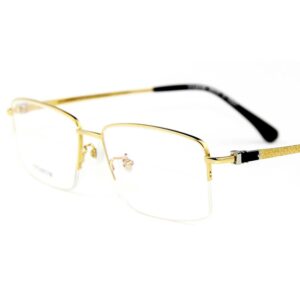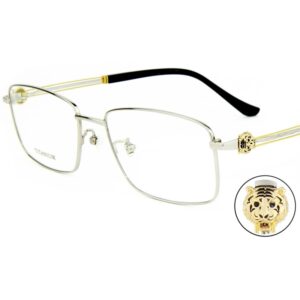Eyeglasses are not just tools for seeing clearly; they are also fashion statements. Among all the components of eyeglasses, the hinges play a crucial role—they connect the frame to the temples, allowing you to fold and unfold your glasses with ease. If the hinges fail, even the best frames become useless. But did you know that making precise and durable hinges is not an easy task? This is why more and more manufacturers are turning to high-precision stamping technology for producing metal eyeglass hinges.
What is High-Precision Stamping Technology?
Let’s start with a simple explanation of high-precision stamping technology. High-precision stamping is an advanced metal processing technique. The basic principle is quite straightforward: imagine placing a metal sheet into a specially designed mold, and then using tremendous pressure to shape the metal into the desired form. That’s the essence of stamping. The “high precision” aspect means that this process is extremely accurate, with virtually no margin for error. Using this technology, we can produce complex and finely detailed metal parts, with each part being almost identical in size and shape.
In eyeglass manufacturing, this technology is primarily used to produce metal hinges. Hinges require high precision; otherwise, they can become loose over time, potentially leading to eyewear failure. High-precision stamping technology ensures that each hinge is produced with exceptional accuracy and consistency, greatly improving the quality and longevity of the eyewear.
How Does High-Precision Stamping Technology Work in the Production of Metal Eyewear Hinges?
To better understand how high-precision stamping technology functions in hinge production, let’s look at a specific case. A well-known eyeglass manufacturer implemented this technology in their production line, resulting in significant improvements in both efficiency and product quality.
Case Study: High-Precision Stamping Technology in a Large Eyewear Manufacturer
This company chose stainless steel as the primary material for its hinges due to its excellent strength and corrosion resistance, which are ideal for components like hinges that undergo frequent use. By introducing high-precision stamping technology, the company managed to control the production error within 2 microns, ensuring high consistency in every batch of products.
- Mold Design and Manufacturing: The factory used advanced CAD/CAM software to design high-precision molds, with a manufacturing accuracy of ±1 micron. This extreme precision ensures that every hinge matches the design specifications perfectly.
- Stamping Process: Once the molds were ready, metal sheets were processed into hinge parts using an automated stamping press. The equipment used by the company applied up to 300 tons of pressure to ensure optimal metal shaping during the process. The dimensional accuracy of the formed hinges remained within ±2 microns.
- Post-Processing: The stamped hinges underwent additional processes such as deburring, polishing, and heat treatment. These steps enhanced the surface smoothness and overall durability of the hinges. As a result, the surface roughness of the hinges was reduced to 0.1 microns, far below the industry average of 0.5 microns.
Thanks to this precise production process, the company not only improved product quality but also increased production line efficiency by 30%, saving over $200,000 in annual production costs.
Why Should Manufacturers Adopt High-Precision Stamping Technology?
The advantages of adopting high-precision stamping technology are obvious. Let’s explore how this technology benefits the production of eyeglass hinges in detail.
1. Increased Production Efficiency
First, let’s talk about production efficiency. Traditional methods for manufacturing hinges, such as CNC machining and casting, can produce high-quality hinges, but they are often slower. For example, CNC machining can produce about 100 hinges per hour, while high-precision stamping technology can produce over 500 hinges in the same amount of time. In the case mentioned earlier, the manufacturer cut the production cycle in half after implementing high-precision stamping technology, allowing them to produce nearly 500,000 more hinges annually, significantly boosting production efficiency.
2. Reduced Production Costs
Next is the reduction in production costs. High-precision stamping technology greatly reduces material waste through precise mold design and improved material utilization. The manufacturer in the case study optimized their mold design, increasing material utilization from 85% to 98%, saving about 10% in material costs annually, which amounted to approximately $150,000. Additionally, the high level of automation in the stamping process reduced labor costs, saving another $50,000 in annual labor expenses.
3. Enhanced Product Quality
Most importantly, product quality saw significant improvements. Through precise mold design and stringent process control, stamping technology ensures that each hinge’s dimensional error is kept within ±2 microns—a level of accuracy that traditional CNC machining cannot easily achieve. This means that both the visual appeal and functional performance of these hinges are superior. In practice, the company found that customer returns decreased by 40% after adopting high-precision stamping technology, greatly enhancing the brand’s market reputation.
To provide a more visual comparison, here’s a table that contrasts high-precision stamping technology with traditional manufacturing methods:
| Manufacturing Method | Precision | Production Speed | Material Utilization | Production Cost | Surface Roughness |
| CNC Machining | ±10 microns | 100 units/hour | 85% | High | 0.5 microns |
| Casting | ±20 microns | 200 units/hour | 75% | Moderate | 1.0 microns |
| High-Precision Stamping | ±2 microns | 500 units/hour | 98% | Low | 0.1 microns |
As shown in the table, high-precision stamping technology outperforms traditional methods in several key areas, making it increasingly popular among manufacturers.
Key Questions Answered
1. What are the advantages of using high-precision stamping technology for metal eyewear hinges?
High-precision stamping technology offers several advantages in the production of metal eyewear hinges:
- High Design Precision: The dimensional error of stamped hinges is minimal, which is critical in mass production. In the case study, the manufacturer achieved a dimensional error of within ±2 microns, more than five times better than traditional CNC machining.
- Strong Production Consistency: Consistency is crucial in mass production. Stamping technology ensures that each batch of hinges has the same dimensions and shape, guaranteeing product stability. The consistency rate of the manufacturer’s products reached 99.9%, far exceeding the industry average of 95%.
- Increased Hinge Durability: Stamped hinges have smooth surfaces and dense internal structures, greatly enhancing durability. In the case study, the hinges retained their functionality even after 100,000 open-close cycles, a 30% improvement in durability.
- Reduced Material Waste: The improved material utilization in the stamping process significantly reduces waste. The waste rate decreased from 15% to less than 2%, saving the manufacturer over $150,000 annually in material costs.
- Cost-Effective: High-precision stamping technology can deliver high quality while reducing production costs, translating into higher profit margins for manufacturers. The company increased its net profit by approximately 10% after adopting this technology.
2. How does high-precision stamping technology compare with traditional manufacturing methods?
Let’s take a closer look at how high-precision stamping technology stacks up against traditional methods:
- Precision: High-precision stamping achieves ±2 microns of accuracy, while traditional CNC machining typically reaches ±10 microns. For complex hinge components, stamping can complete the process in one step, while CNC machining often requires multiple cuts, which can compromise accuracy.
- Production Speed: Stamping technology is extremely fast and ideal for large-scale production. For example, it can produce 500 hinges per hour compared to 100 hinges with CNC machining.
- Cost: Stamping reduces material waste and labor costs, making it more cost-effective than CNC machining and casting. The manufacturer reduced their unit hinge production cost by about 20% after implementing stamping technology.
- Material Utilization: Stamping offers the highest material utilization, minimizing waste and reducing environmental impact. In contrast, CNC machining generates a large amount of scrap, and casting often requires additional post-processing.
3. Which metals are best suited for high-precision stamping of eyewear hinges?
Choosing the right metal is crucial in the high-precision stamping process. Here are some commonly used metals and their suitability:
- Stainless Steel: Due to its excellent corrosion resistance and strength, stainless steel is ideal for eyewear hinges. With high-precision stamping, stainless steel can be shaped into highly precise and durable hinges, making it suitable for everyday wear. In the case study, the production error for stainless steel hinges was just ±2 microns, far exceeding industry standards.
- Titanium Alloy: Titanium alloy is lightweight and corrosion-resistant, making it popular for high-end eyewear hinges. Although titanium is challenging to work with, high-precision stamping technology can overcome this, producing lightweight yet durable hinges. Titanium hinges are 40% lighter than stainless steel, but nearly as strong, making them ideal for high-performance eyewear.
- Aluminum Alloy: Aluminum alloy is lightweight and easy to process, making it suitable for children’s glasses or fashion eyewear. Although aluminum is relatively soft, high-precision stamping technology can achieve a smoother surface, extending its service life. The production error for aluminum hinges is kept within ±5 microns, extending their lifespan by approximately 25%.
4. What challenges are faced when implementing high-precision stamping technology?
Despite its many advantages, high-precision stamping technology poses some challenges in actual implementation:
- High Initial Equipment Costs: The initial investment in high-precision stamping equipment and molds can be significant. For example, the company in the case study invested nearly $1 million in upgrading equipment and molds. However, this investment paid off with a positive return within two years.
- Need for Skilled Operators: Operating high-precision stamping equipment is complex, requiring skilled professionals for operation and maintenance. Companies must invest considerable time and resources in training operators. The company provided a three-month professional training program for its operators to ensure smooth production.
- Mold Maintenance: Stamping molds can wear out during high-intensity production, requiring regular maintenance and replacement. Mold maintenance typically accounts for about 5% of total costs. To address this challenge, the company established a dedicated mold maintenance team to regularly inspect and maintain molds, ensuring their long-term use.
5. How does high-precision stamping technology improve the overall quality and lifespan of eyewear?
Eyewear hinges produced with high-precision stamping technology are not only highly accurate but also extremely durable. In the case study, the company increased the lifespan of its hinges by over 30% using this technology. This improvement not only enhanced the user experience but also reduced the frequency of replacements due to hinge issues.
Moreover, the stamping process produces hinges with smooth surfaces and tight structures, making them less prone to loosening or deformation over time, thereby extending the overall lifespan of the eyewear. Durability tests showed that the hinges produced using stamping technology remained intact after 100,000 open-close cycles, whereas traditionally manufactured hinges typically showed wear after 80,000 cycles.
Conclusion
High-precision stamping technology has brought significant improvements to the production of metal eyewear hinges. It not only enhances the precision and consistency of the hinges but also reduces production costs and increases the competitiveness of the products in the market. In the eyewear industry, especially for brands that prioritize high quality and performance, high-precision stamping technology is undoubtedly a worthwhile investment. As eyewear design and manufacturing technologies continue to evolve, high-precision stamping technology will play an increasingly important role in this field. If you are an eyewear manufacturer or are interested in eyewear production, understanding and mastering this technology will provide you with significant business opportunities and technical advantages.
FAQ: High-Precision Stamping Technology in Metal Eyewear Hinges Production
1. What is high-precision stamping technology?
High-precision stamping technology is an advanced metal processing method that involves shaping metal sheets into complex and detailed components using specialized molds and high-pressure stamping machines. This technology ensures extremely accurate production with minimal errors, making it ideal for creating precise and consistent parts like metal eyewear hinges.
2. Why is high-precision stamping important for eyewear hinges?
Eyewear hinges require high precision to function correctly, as even small deviations can lead to loose or misaligned hinges that compromise the overall quality and durability of the glasses. High-precision stamping allows manufacturers to produce hinges with exceptional accuracy, ensuring long-lasting performance and a superior fit.
3. What materials are commonly used in high-precision stamping for eyewear hinges?
The most commonly used materials include:
- Stainless Steel: Known for its strength and corrosion resistance, stainless steel is ideal for everyday eyewear.
- Titanium Alloy: Lightweight and strong, titanium is popular for high-end eyewear.
- Aluminum Alloy: Lightweight and easily shaped, aluminum is often used in children’s and fashion eyewear.
4. How does high-precision stamping compare to traditional manufacturing methods like CNC machining?
High-precision stamping offers several advantages over traditional methods like CNC machining:
- Precision: Achieves accuracy of ±2 microns compared to ±10 microns in CNC machining.
- Speed: Can produce 500 hinges per hour versus 100 hinges with CNC machining.
- Material Utilization: Utilizes up to 98% of the material, reducing waste significantly.
- Cost: More cost-effective in large-scale production due to reduced material waste and faster production times.
5. What are the key benefits of using high-precision stamping for eyewear hinges?
The key benefits include:
- High Precision: Extremely accurate production with minimal errors.
- Consistent Quality: Ensures uniformity in large-scale production.
- Increased Durability: Produces hinges with enhanced strength and longevity.
- Cost Efficiency: Reduces material waste and labor costs, leading to lower production costs.
- Improved Surface Quality: Produces hinges with smoother surfaces, reducing wear and tear.
6. What challenges are associated with implementing high-precision stamping technology?
- High Initial Investment: The cost of high-precision stamping equipment and molds can be significant.
- Skilled Labor Requirement: Operating and maintaining high-precision equipment requires skilled personnel.
- Mold Maintenance: Regular maintenance of molds is necessary to ensure consistent quality, which can add to operational costs.
7. How does high-precision stamping impact the overall quality and lifespan of eyewear?
High-precision stamping significantly enhances the overall quality of eyewear by producing hinges with superior accuracy and durability. The technology reduces the likelihood of hinge failure, extends the lifespan of the eyewear, and improves the overall user experience.
8. Is high-precision stamping technology suitable for all types of eyewear production?
High-precision stamping is particularly beneficial for the production of metal eyewear hinges and components that require high accuracy and consistency. It is especially suited for manufacturers who produce high volumes of eyewear and those who prioritize quality and durability in their products.
9. What kind of return on investment (ROI) can manufacturers expect from adopting high-precision stamping technology?
While the initial investment in high-precision stamping technology is high, manufacturers can expect a significant return on investment due to increased production efficiency, reduced material costs, and enhanced product quality. In some cases, the ROI can be realized within 2 years of implementation.
10. Can high-precision stamping be used for custom or small-batch eyewear production?
Although high-precision stamping is most cost-effective for large-scale production, it can also be used for custom or small-batch production if the manufacturer has the necessary resources to create specialized molds. However, the cost-benefit ratio may vary depending on the scale of production.
























